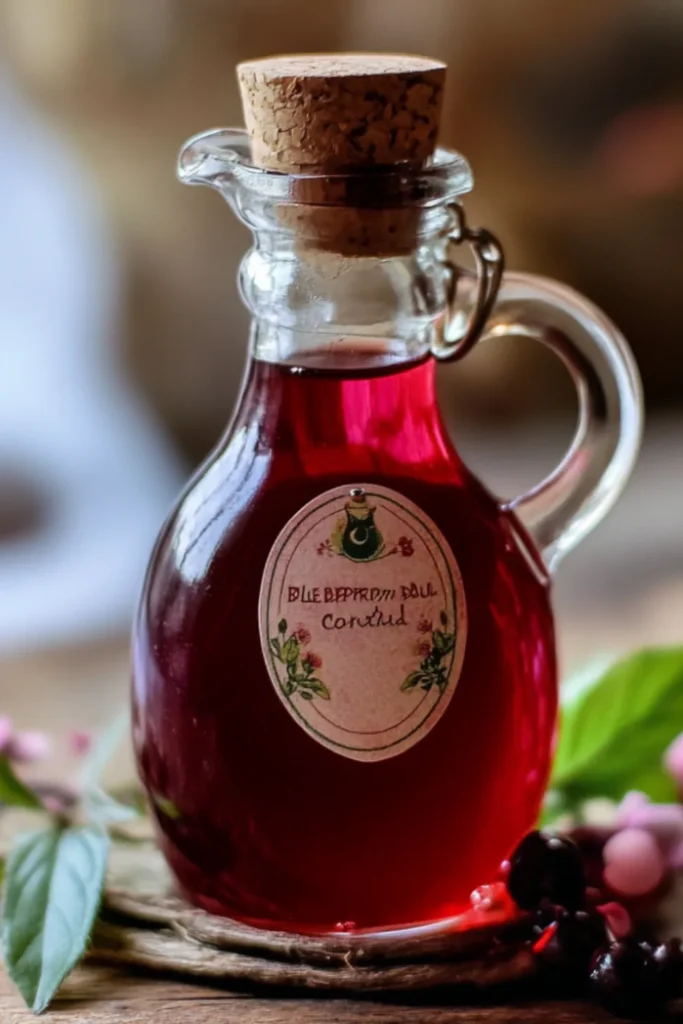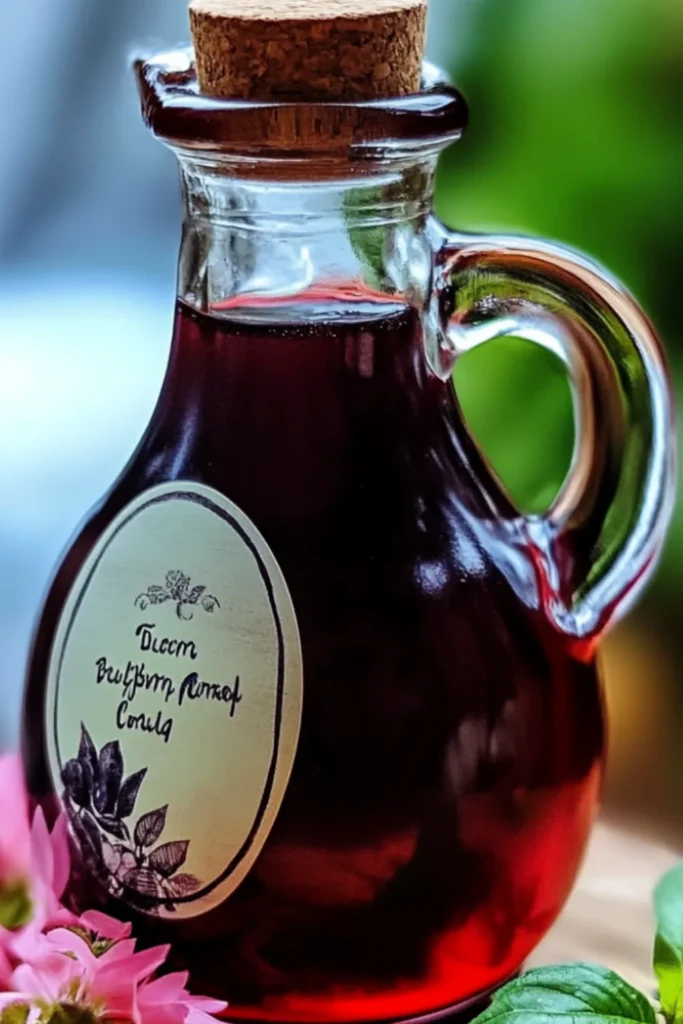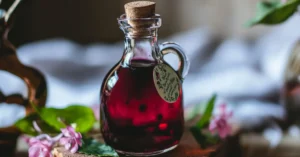Table of Contents
Imagine sipping a cool, fragrant drink that not only delights your taste buds but also soothes your body and mind. That’s the magic of herbal cordial recipe—a concentrated, sweetened infusion of herbs that’s as versatile as it is delicious. Whether you’re a wellness enthusiast, a cocktail lover, or simply someone who enjoys experimenting in the kitchen, herbal cordials offer a world of possibilities.
In this article, we’ll explore everything you need to know about herbal cordials, from their rich history and health benefits to step-by-step recipes and creative uses. By the end, you’ll be inspired to create your own signature cordial and enjoy the natural goodness of herbs in every sip.
Introduction and Overview of Herbal Cordial Recipe
Herbal cordials have been cherished for centuries, blending the art of herbalism with the joy of crafting delicious beverages. These sweet, aromatic infusions are made by steeping herbs in water or alcohol, then sweetening the mixture to create a concentrated syrup. Today, they’re making a comeback as people seek natural, flavorful alternatives to store-bought drinks.

From refreshing summer spritzers to soothing winter tonics, herbal cordials are incredibly versatile. Plus, they’re easy to make at home, allowing you to customize flavors and ingredients to suit your taste and health needs.
What is Herbal Cordial Recipe?
So, what exactly is herbal cordial Recipe ? At its core, it’s a liquid extract made by infusing herbs in water, alcohol, or a combination of both. The mixture is then sweetened with natural sweeteners like honey, sugar, or stevia, resulting in a concentrated syrup that can be diluted with water, added to cocktails, or used in cooking.
Unlike herbal teas, which are typically consumed immediately, herbal cordials are preserved and stored for later use. This makes them a convenient way to enjoy the benefits of herbs year-round.
Why Make Herbal Cordial Recipe at Home?
While you can buy herbal cordials from specialty stores, making them at home has its perks. For starters, you have complete control over the ingredients, ensuring a fresh, high-quality product. Plus, homemade cordials are free from artificial additives and preservatives, making them a healthier choice.
But perhaps the best part is the creativity it allows. You can experiment with different herbs, sweeteners, and flavor combinations to create a cordial that’s uniquely yours. Whether you’re crafting a soothing
History and Cultural Significance of Herbal Cordials
Herbal cordials aren’t just a modern trend—they’re steeped in history and tradition. From ancient apothecaries to modern mixology, these fragrant infusions have played a role in cultures around the world. In this section, we’ll explore the origins of herbal cordials, their cultural significance, and how they’ve evolved over time.
The Origins of Herbal Cordials
The use of herbs for medicinal and culinary purposes dates back thousands of years. Early civilizations, from the Egyptians to the Chinese, recognized the healing properties of plants and often infused them into liquids to create tonics and elixirs. These early herbal cordials were used to treat ailments, boost energy, and even ward off evil spirits.
In medieval Europe, monasteries became centers of herbal knowledge, where monks cultivated gardens and crafted herbal remedies. Herbal cordials were a staple in their apothecaries, often used to soothe digestive issues, calm nerves, or simply provide a sweet treat.
Herbal Cordials in Modern Times
Fast forward to today, and herbal cordials are enjoying a renaissance. As people embrace natural remedies and artisanal foods, these infusions have found their way into modern kitchens and bars. They’re no longer just medicinal—they’re a way to add flavor and flair to beverages, desserts, and even savory dishes.
More recipes: San Giorgio Lasagna Recipe
The rise of the craft beverage movement has also played a role in their popularity. Mixologists are using herbal cordials to create unique cocktails, while wellness enthusiasts are turning to them for their health benefits. From elderflower spritzers to ginger-turmeric tonics, herbal cordials are proving that old-world remedies can be both functional and fashionable.
Cultural Variations
Different cultures have their own versions of herbal cordials, each with unique ingredients and uses. Here are a few examples:
- Elderflower Cordial: A classic in Europe, especially in the UK and Scandinavia, elderflower cordial is made from the fragrant blossoms of the elder tree. It’s often mixed with sparkling water for a refreshing summer drink.
- Rosehip Cordial: Popular in Eastern Europe, rosehip cordial is rich in vitamin C and is often used to boost immunity during the colder months.
- Hibiscus Cordial: In the Caribbean and parts of Africa, hibiscus flowers are used to make a vibrant, tart cordial that’s perfect for cocktails and mocktails.
Fun Fact: In some cultures, herbal cordials were believed to have magical properties. For example, elderflower cordial was thought to protect against evil spirits, while rosehip cordial was used to attract love and prosperity.
Health Benefits of Herbal Cordials
Beyond their delightful flavors, herbal cordials offer a host of health benefits. Packed with vitamins, minerals, and antioxidants, these natural infusions can support everything from digestion to immunity. In this section, we’ll dive into the nutritional value of herbal cordials, their medicinal uses, and the benefits of using natural sweeteners.
Nutritional Value of Herbal Cordials
The health benefits of herbal cordials largely depend on the herbs used. Many herbs are rich in essential nutrients and bioactive compounds that can promote overall well-being. Here’s a quick look at some common herbs and their nutritional profiles:
- Elderflower: High in antioxidants and vitamin C, elderflower is known for its immune-boosting properties.
- Mint: Contains menthol, which can aid digestion and soothe upset stomachs.
- Rosehip: Packed with vitamin C, rosehip supports skin health and immunity.
- Lavender: Known for its calming effects, lavender can help reduce stress and improve sleep quality.
Pro Tip: Combining different herbs in your cordial can create a synergistic effect, enhancing both flavor and health benefits.
Medicinal Uses
Herbal cordials have long been used as natural remedies for various ailments. Here are some ways they can support your health:
- Digestive Aid: Herbs like mint, ginger, and fennel can soothe indigestion and bloating.
- Immune Support: Elderflower, rosehip, and echinacea are known for their immune-boosting properties.
- Stress Relief: Lavender, chamomile, and lemon balm can help calm the mind and promote relaxation.
- Anti-Inflammatory: Turmeric and ginger are powerful anti-inflammatory herbs that can help reduce pain and swelling.
Did You Know? Many herbal cordials were originally created as medicinal tonics, often prescribed by herbalists and healers.
Natural Sweeteners and Their Benefits
While sugar is a common ingredient in herbal cordials, there are plenty of natural sweeteners to choose from, each with its own benefits:
- Honey: Rich in antioxidants and antimicrobial properties, honey adds a rich, floral sweetness.
- Maple Syrup: Contains minerals like zinc and manganese, making it a nutritious alternative to sugar.
- Stevia: A zero-calorie sweetener derived from the stevia plant, ideal for those watching their sugar intake.
Pro Tip: When using natural sweeteners, adjust the amount to taste, as they can vary in sweetness compared to sugar.
Ingredients and Tools Needed
Making herbal cordials at home is easier than you might think, but having the right ingredients and tools is key to success. In this section, we’ll break down everything you need to get started, from essential herbs and sweeteners to the equipment that makes the process a breeze.
Essential Ingredients for Herbal Cordial Recipe
The beauty of herbal cordials lies in their simplicity. With just a few high-quality ingredients, you can create a flavorful and healthful infusion. Here’s what you’ll need:
- Herbs:
- Fresh or dried herbs are the star of the show. Popular choices include:
- Elderflower: Fragrant and floral, perfect for summer drinks.
- Mint: Refreshing and great for digestion.
- Rosehip: Tart and rich in vitamin C.
- Lavender: Calming and aromatic.
- Fresh or dried herbs are the star of the show. Popular choices include:
- Sweeteners:
- Choose a natural sweetener to balance the herbal flavors:
- Honey: Adds a rich, floral sweetness.
- Sugar: Classic and easy to use.
- Maple Syrup: Adds a hint of caramel flavor.
- Stevia: A zero-calorie option for those watching their sugar intake.
- Choose a natural sweetener to balance the herbal flavors:
- Liquid Base:
- Water is the most common base, but you can also use alcohol (like vodka or gin) for a longer shelf life and a boozy twist.
- Flavor Enhancers:
- Citrus zest, spices (like cinnamon or ginger), or vanilla can add depth and complexity to your cordial.
Optional Add-Ins and Variations
Want to get creative? Here are some ideas for customizing your herbal cordial Recipe :
- Fruit Infusions: Add berries, citrus slices, or apple chunks for a fruity twist.
- Spices: Experiment with cinnamon sticks, star anise, or cardamom pods for warmth and complexity.
- Alcohol: For an adult version, infuse your cordial with vodka, gin, or rum.
Pro Tip: Keep a notebook to record your favorite combinations. That way, you can recreate them or tweak them next time.
Tools and Equipment
You don’t need a fully stocked kitchen to make herbal cordials, but a few basic tools will make the process smoother:
- Jars or Bottles:
- Glass jars with tight-fitting lids are ideal for steeping and storing your cordial.
- Strainer or Cheesecloth:
- Use a fine-mesh strainer or cheesecloth to remove herbs and solids after steeping.
- Funnel:
- A small funnel makes it easy to transfer your cordial into bottles without spills.
- Saucepan:
- For heating water and dissolving sweeteners.
- Measuring Tools:
- A kitchen scale or measuring cups and spoons ensure accuracy.
Optional Tools:
- Mortar and Pestle: For crushing herbs and spices to release their flavors.
- Infusion Bags: Handy for containing loose herbs during steeping.

Step-by-Step Herbal Cordial Recipes
Ready to make your own herbal cordial Recipe ? Whether you’re a beginner or a seasoned pro, these step-by-step recipes will guide you through the process. From a basic herbal cordial Recipe to creative variations, you’ll find everything you need to create delicious, aromatic infusions at home.
Basic Herbal Cordial Recipe
This simple recipe is a great starting point for making herbal cordials. Once you’ve mastered the basics, you can experiment with different herbs and flavors.
Ingredients:
- 2 cups fresh herbs (e.g., mint, elderflower, or lavender) or 1 cup dried herbs
- 4 cups water
- 2 cups sugar (or 1 cup honey/maple syrup)
- Optional: Citrus zest, spices, or vanilla for added flavor
Instructions:
- Prepare the Herbs:
- Rinse fresh herbs gently and pat them dry. If using dried herbs, measure them out.
- Make the Infusion:
- In a saucepan, bring the water to a gentle simmer. Add the herbs and any optional flavorings (like citrus zest or spices).
- Remove from heat, cover, and let steep for 1-2 hours. The longer it steeps, the stronger the flavor.
- Strain the Mixture:
- Strain the liquid through a fine-mesh strainer or cheesecloth into a clean bowl or jar. Discard the herbs.
- Add Sweetener:
- Return the infused liquid to the saucepan and heat gently. Add the sugar (or honey/maple syrup) and stir until fully dissolved.
- Cool and Store:
- Let the cordial cool completely, then transfer it to sterilized bottles or jars. Store in the fridge for up to 2-4 weeks.
Pro Tip: For a clearer cordial, avoid squeezing the herbs when straining, as this can release bitter compounds.
Popular Herbal Cordial Recipe Variations
Once you’ve mastered the basic recipe, try these popular variations:
Elderflower Cordial
- Ingredients: 2 cups fresh elderflower heads, 4 cups water, 2 cups sugar, 2 lemons (zested and juiced).
- Instructions: Follow the basic recipe, adding the lemon zest and juice with the elderflowers.
Mint Cordial
- Ingredients: 2 cups fresh mint leaves, 4 cups water, 2 cups sugar, 1 lime (zested and juiced).
- Instructions: Add the lime zest and juice with the mint for a refreshing twist.
Rosehip Cordial
- Ingredients: 2 cups dried rosehips, 4 cups water, 2 cups honey, 1 cinnamon stick.
- Instructions: Simmer the rosehips and cinnamon stick for 20 minutes before straining and adding honey.
Creative Flavor Combinations
Feeling adventurous? Try these unique recipes:
- Lavender-Lemon Cordial:
- Combine fresh lavender with lemon zest and juice for a floral, citrusy infusion.
- Ginger-Turmeric Cordial:
- Add fresh ginger slices and turmeric root for a spicy, anti-inflammatory tonic.
- Berry-Basil Cordial:
- Mix fresh basil with raspberries or blackberries for a sweet and herbaceous blend.
Pro Tip: When experimenting with new flavors, start with small batches to avoid wasting ingredients.
Tips for Perfect Infusion
To get the most out of your herbal cordial Recipe, keep these tips in mind:
- Use Fresh, High-Quality Herbs:
- Fresh herbs generally yield better flavor, but dried herbs work well too.
- Don’t Overheat:
- Avoid boiling the herbs, as high heat can destroy delicate flavors and nutrients.
- Taste as You Go:
- Adjust the sweetness and steeping time to suit your preferences.
- Sterilize Your Bottles:
- Clean bottles with boiling water to extend the shelf life of your cordial.
Uses for Herbal Cordials
Herbal cordials are incredibly versatile, making them a must-have in any kitchen. Whether you’re looking to whip up a refreshing drink, craft a unique cocktail, or add a twist to your cooking, these infusions have you covered. In this section, we’ll explore the many ways you can use herbal cordials to elevate your beverages, meals, and even your wellness routine.
Beverages
One of the simplest and most popular ways to enjoy herbal cordials is by turning them into delicious drinks. Here are some ideas:
- Sparkling Herbal Spritzer:
- Mix 1-2 tablespoons of cordial with sparkling water and ice for a refreshing, non-alcoholic drink.
- Garnish with fresh herbs or citrus slices for a fancy touch.
- Iced Herbal Tea:
- Dilute the cordial with cold water and serve over ice for a quick and easy iced tea.
- Hot Herbal Toddy:
- Stir a spoonful of cordial into hot water or tea for a soothing winter drink. Add a splash of lemon or honey for extra warmth.
Pro Tip: For a festive twist, add a splash of elderflower cordial to champagne or prosecco.
Cocktails and Mocktails
Herbal cordials are a bartender’s secret weapon, adding depth and complexity to cocktails and mocktails alike. Here are some recipes to try:
- Elderflower Gin Fizz:
- Mix 1 oz gin, 1 oz elderflower cordial, and 2 oz sparkling water. Shake with ice and serve in a chilled glass.
- Mint Mojito Mocktail:
- Muddle fresh mint leaves with lime juice, then add 1 oz mint cordial and top with soda water.
- Lavender Lemonade Cocktail:
- Combine 1 oz vodka, 1 oz lavender cordial, and 3 oz lemonade. Serve over ice with a sprig of lavender.
Fun Fact: Herbal cordials are a great way to add flavor without overpowering the drink, making them perfect for both cocktails and mocktails.
Culinary Uses
Herbal cordials aren’t just for drinks—they can also add a unique twist to your cooking. Here’s how:
- Desserts:
- Drizzle rosehip cordial over vanilla ice cream or yogurt.
- Use lavender cordial to flavor cakes, cookies, or glazes.
- Sauces and Marinades:
- Add a splash of ginger-turmeric cordial to stir-fry sauces or marinades for a sweet and spicy kick.
- Salad Dressings:
- Whisk elderflower cordial with olive oil, vinegar, and mustard for a floral vinaigrette.
Pro Tip: Start with a small amount of cordial and adjust to taste, as the flavors can be quite concentrated.
Medicinal Applications
Herbal cordials have long been used as natural remedies, and they’re still a great way to support your health. Here are some ideas:
- Digestive Aid:
- Sip a small glass of mint or ginger cordial after meals to soothe digestion.
- Immune Boost:
- Mix elderflower or rosehip cordial with warm water and honey for a vitamin C-rich tonic.
- Stress Relief:
- Enjoy a calming drink made with lavender or chamomile cordial before bed to promote relaxation.
Did You Know? Many herbal cordials were originally created as medicinal tonics, often prescribed by herbalists and healers.
Storing and Preserving Herbal Cordials
Once you’ve made your herbal cordial Recipe, proper storage is key to maintaining its freshness and flavor. Whether you’re planning to enjoy it right away or save it for later, these tips will help you get the most out of your homemade infusion.
Proper Storage Techniques
To keep your herbal cordial Recipe fresh and flavorful, follow these storage guidelines:
- Use Sterilized Bottles:
- Clean glass bottles or jars with boiling water to kill any bacteria. Let them dry completely before filling.
- Refrigerate:
- Store your cordial in the fridge to extend its shelf life. Most homemade cordials will last 2-4 weeks when refrigerated.
- Label and Date:
- Write the name of the cordial and the date it was made on the bottle. This helps you keep track of freshness.
Pro Tip: Use dark glass bottles to protect the cordial from light, which can degrade its quality over time.
Shelf Life and Preservation
The shelf life of your herbal cordial Recipe depends on the ingredients and storage method. Here’s what to expect:
- Non-Alcoholic Cordials:
- Typically last 2-4 weeks in the fridge.
- To extend shelf life, consider adding a small amount of alcohol (like vodka) as a preservative.
- Alcoholic Cordials:
- Can last several months when stored in a cool, dark place.
Did You Know? Adding citrus juice or vinegar can also help preserve your cordial, as the acidity inhibits bacterial growth.
Freezing Herbal Cordials
If you’ve made a large batch and want to save some for later, freezing is a great option. Here’s how:
- Portion the Cordial:
- Pour the cordial into ice cube trays or small containers for easy portioning.
- Freeze:
- Place the trays or containers in the freezer until solid.
- Thaw:
- When ready to use, thaw the cordial in the fridge or at room temperature.
Pro Tip: Frozen cordial cubes are perfect for adding to drinks or recipes without diluting the flavor.
Frequently Asked Questions About Herbal Cordials
1. What is the difference between herbal cordial and syrup?
- Herbal cordial Recipe is a concentrated infusion of herbs, often sweetened and used as a flavoring agent. Syrup, on the other hand, is thicker and sweeter, typically used as a topping or sweetener.
2. Can I use dried herbs for herbal cordials?
- Yes, dried herbs work well, but they may require a longer steeping time to release their flavors. Use about half the amount of dried herbs compared to fresh.
3. How long does homemade herbal cordial Recipe last?
- Most homemade cordials last 2-4 weeks in the fridge. Adding alcohol or citrus juice can extend the shelf life.
4. Are herbal cordials alcoholic?
- They can be made with or without alcohol. Non-alcoholic versions are great for kids and those avoiding alcohol, while alcoholic versions have a longer shelf life.
5. Can I use herbal cordials for kids?
- Absolutely! Just avoid alcoholic versions and opt for natural sweeteners like honey or maple syrup.
6. What are the best herbs for beginners?
- Mint, elderflower, and lemon balm are great starting points because they’re easy to work with and have mild, pleasant flavors.
7. Why didn’t my cordial turn out flavorful?
- This could be due to using low-quality herbs, insufficient steeping time, or not enough sweetener. Adjust the recipe and taste as you go next time.
8. Can I freeze herbal cordials?
- Yes, freezing is a great way to preserve cordials. Pour them into ice cube trays or small containers for easy portioning.




